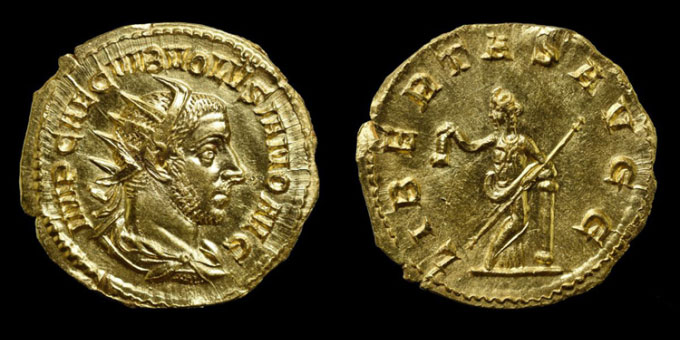The 1,700-year-old 5.6-gram gold coin features the emperor Volusianus and Libertas on both sides.
A museologist at the Rippl-Rónai museum, in the city of Kaposvár, and volunteers dug a rare Roman gold coin earlier this year. The coin depicts the emperor Volusianus, who with his father ruled the Roman Empire for about two years.

The Roman coin has one side depicting the emperor Volusianus, the other side is the god of liberty Libertas.
The Roman coin has one side depicting the emperor Volusianus, the other side is the god of liberty Libertas. (Photo: Krisztian Balla)
At the age of 22, Volusianus was murdered by his own soldiers. Because Volusian’s reign was so short, there were very few coins engraved with his face. Besides, it is also very rare to find Roman gold coins of this denomination in Hungary, according to Máté Varga, an archaeologist at the University of Szeged who led the excavation team.
Experts have not yet identified the coin’s owner. This is the only gold coin unearthed in this area so it is likely that someone has lost it. “It must be a great loss to the former owner to lose such a valuable coin,” Varga said.
The team found the coin while excavating a Roman settlement in Somogy, southwestern Hungary, but Varga did not disclose the exact location. “The exact location is kept secret at the moment as the archaeological site is still under investigation. Illegal metal detectors are a big problem in Hungary so we can’t reveal the location yet.” he explained.
A gold coin weighing 5.6 grams was minted under the emperor Volusianus, from 251 to 253. One side of the coin is a portrait of the emperor with a thick beard, crowned head. The other side depicts Libertas, the god of freedom.
This coin is also not a “change of money”. “The face value of the coin is not the common aureus but the rare binio with double the value of aureus,” said Marjanko Pilekić, a researcher at the Schloss Friedenstein Gotha Foundation Coins Department (Germany).
Pilekić commented, the coin discovery was “awesome and exciting”. “Judging by the photo, the condition of the coin is also very good,” he said. The coin is now part of the currency collection in the Rippl-Rónai museum.
Archaeological work at the site where the coin was discovered is still ongoing. Based on unearthed artifacts, including gold coins, it seems likely that the Roman settlement existed in the 3rd and 4th centuries, when it was part of the Roman province of Pannonia Superior. Other artifacts include several Roman silver and bronze coins, a bronze key, an inscribed silver ring and a glass pin.





